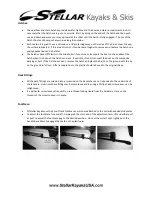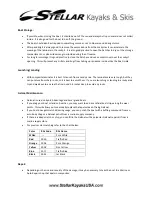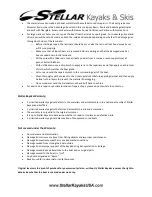
For replacing the skeg, you will run the wire that is attached to the skeg back into the skeg box and then
with the bottom edge of the skeg at 90 degrees to the boat, put the tip into the locking bar. Slowly feed
the wire into the skeg box making sure not to kink the wire. The wire will exit into the handle housing on
the deck where you will need to feed it through the handle and back into the tubing on the bow side of
the box. Once the skeg is fully retracted, move the handle to the bow end of the slider box and tighten
the screw fully
If the skeg becomes sticky or tough to operate, this may be due to debris getting stuck in the skeg box or
the tubing. Sometimes this can be flushed out with a hose, but sometimes, the skeg may need to be
removed and then flushed out. You can use air or water to flush out the tubing, which should be applied
from the slider box to flush any debris back through the hull.
Transportation:
When transporting your boats, it is best that your rack or cradle has some sort of padding. If you are
using a straight bar, you can use pipe insulation to wrap around the cross bar or buy a U-shaped foam pad
which conforms to the shape of the deck. The padding will help reduce any stress points on the boat
when strapping it down.
When strapping the boat down, you can strap it hull or deck down, but realize that if it is hull down and
your cockpit is open, it can collect rain inside, which with enough weight can hurt the boat. You also want
to avoid strapping the boat down to a bar on the hatches – in summer heat, this can distort the hatches.
Never use a boat strap that is frayed or brittle, a broken $5 boat strap can cause thousands of dollars in
damage.
Boat straps usually come with each boat, but can also be purchased at a store. These straps are flat
webbing, with a cam buckle to reduce the stress on the boat. Never use the ratcheting kind of straps as
they can tighten to such a degree that they will crush the boat. The level of tension that you want to
place on the strap is one where you do not bend the boat from the pressure, but also not so loose that
the boat has any lateral movement. Simply grab the bow or stern and push to the side to see how secure
it is.
It is generally recommended that a bow and stern line be used to add additional stability to any boat that
is car topped.
If you have a large overhang, a red or orange flag may be required in your state or province to alert other
drivers of the protrusion coming from your car
The rudder should be secured to the boat or removed during transportation to keep it from moving to the
side when you are driving. This will prevent wear and tear on the steering system as well as improving
your gas mileage.
Cockpit covers are also a great investment for traveling,
because it keeps your cockpit clean and dry, but more
importantly will greatly reduce the noise of the boat and
also increase your gas mileage.
Once underway, it is a good habit to stop in about 15-20
minutes after starting your trip to check on the boats to
see how your strapping is working. Also, most straps will
loosen in the rain as well, so check them if they get wet.

























